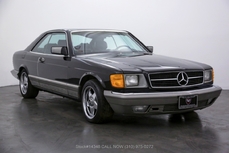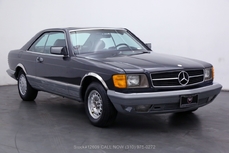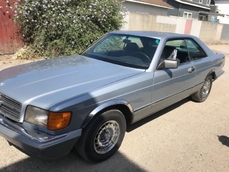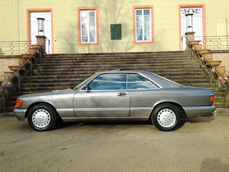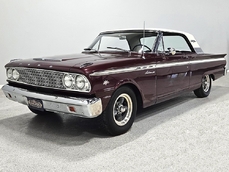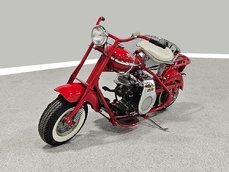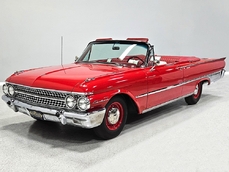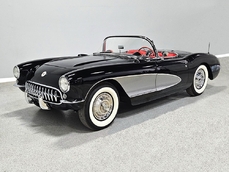Mercedes-Benz 500 SEC w126 5.0 liter V8 1984
General description :
In 1967, former Mercedes-Benz engineers Hans Werner Aufrecht and Erhard Melcher left Mercedes to found their own performance engine tuning house, which they called AMG (the initials from their last names plus the G from Großaspach, which was Aufrecht's birth town). In the ensuing years, AMG would be responsible for some of the fastest Mercedes-Benz engines on the track, and by the late ‘70s they were building bespoke high-performance Mercedes-Benz road cars that included a myriad of modifications including suspension, brakes, engine, interior, and even manual transmissions. By the mid-80s, AMG’s relationship was such that customers could order a new AMG-modified Mercedes-Benz at their local dealership, built to order and delivered through the Mercedes-Benz dealer network. The quality of their work was such that in 1990, Mercedes-Benz bought controlling interest in the firm, and eventually purchased it in its entirety. Today, AMG and Mercedes-Benz are inseparable, representing the absolute pinnacle of German luxury and performance.
That’s a long road to follow, but it helps put this wonderful 1985 Mercedes-Benz 500SEC AMG into better context. Built to customer specifications (that customer’s name, Serge Baghoumian, is still on the delivery tag) and based on the top-of-the-line S-Class coupe, this awesome white hardtop was the ultimate status symbol when it was new and it remains a delightful road car even 35 years later. It came to the US with its original owner in late 1985 as a gray-market import and was federalized in Washington state (which is why it is technically a 1984 model but is titled as a 1985). It has had just three (or four if you consider a dealer briefly owing it) owners from new, with the first owner keeping it until 2002, and the second owner until 2018—rather extraordinary. It’s worth noting that the 500SEC with the 5.0 liter V8 was not available in the US, but it was arguably Mercedes’ best-performing engine at the time. As a Euro-spec car, it offers considerably more power, as well as several unique features that the American market never saw, most notably the absence of catalytic converters and the European-style aero headlights and bumpers. Even without the AMG upgrades, this would probably be a pretty special car.
This is unquestionably a real AMG product, not a conversion, and the AMG serial numbers on the various body parts, wheels, and other components confirm this. The monochromatic white paint that covers almost every square inch of the car is very much a product of the ‘80s, but the restrained AMG body additions neatly avoid a dated look. The Euro bumpers that tuck in tightly to the bodywork, the moderately aggressive chin spoiler with fog lights, and an equally subtle spoiler on the trunk lid all add to the aggressive look, but not at the expense of Mercedes-Benz’s built-in elegance. This was also one of the last hardtop coupes ever built—that means no B-pillar—and it gives the large coupe a sleek, uncluttered look that stands out today. Finish quality is exemplary, as you’d expect, and it has been expertly maintained for the past 35 years. Most of the paint is original, but the bumpers, grille, and right rear quarter panel have been professionally refinished to address chips and marks that inevitably come from use. Today it looks fantastic with a uniform look, zero evidence of rust or accident repairs, and an aggressive demeanor that will stand out without making a lot of noise. The more we look at this car, the more we like it!
The Anthracite Nappa leather interior is likewise largely original and in remarkable condition. A new headliner was installed in 2018 and the driver’s seat insert was replaced in 2019, but the work blends in so seamlessly as to be unnoticeable. The AMG steering wheel may or may not have been installed at the factory, but it’s a wonderful and wholly appropriate addition, particularly with the slightly smaller diameter and leather rim. The seats are supportive but not constricting, and yes, the mechanical arms that hand you the seat belts are still fully operational. In fact, everything works: clock, A/C, windows, gauges, mirrors, and sunroof. The burled walnut you see on the dash and center console is real burled walnut, not a plastic facsimile (what do you expect for the equivalent of $160,000 in 1985?). There’s a newer AM/FM/CD stereo head unit in the center of the dash, which works along with a CD changer in the trunk. That trunk is beautifully finished with plush black carpets, and yes, you’ll find the original tool roll and unused Pirelli spare tire and “pie crust” alloy wheel that have never been used.
The 5.0 liter SOHC M117 V8 wasn’t available in the US, but in Europe it was rated at 228 horsepower and 299 pounds of torque—modest by today’s standards, maybe, but it’s anything but sedate on the road. Of course, it’ll behave like a Mercedes should, starting with a modest Va-ROOOM but settling down to a muted hum. At anything but full-bore, it’s unobtrusive, pulling the big coupe along like an electric motor that you can hear but can’t feel. But put your foot into it and this big German luxury coupe acts like a genuine muscle car, dropping down a gear or two and throwing all that torque at the rear wheels. Something this big shouldn’t really be this fast and in 1985, it was probably one of the meanest machines on the street. Of course, it cruises effortlessly at supra-legal speeds and the insulation is so good that you barely hear anything going on except the sounds the engineers wanted you to hear. It’s thrilling, yet relaxing at the same time. That’s what all that money would buy you in 1985.
And don’t worry, this car has been properly and extensively serviced with receipts to back it up. Work in 2017-2018 includes a new timing chain, camshaft gears, oiler tube bushings, fuel injectors, seals and holders, new Bosch spark plugs, idle control unit, voltage regulator, starter, overload protection relay, new air filter, new ceramic/copper fuses, and a new hood pad. In addition, the power steering pump was serviced and new hoses installed. In short, all the things that worry potential new owners have been addressed and there are receipts for the work to back it up. This is one vintage Mercedes you can buy with confidence.
Underneath, you’ll see no evidence that this car was ever used in winter weather. It has been thoroughly cleaned and pressure washed to show the immaculate original floors. The transmission wears a tag that it is a factory rebuilt unit and it, too, has been recently serviced including a new pan, filter, and gaskets. The suspension features new front guide rod mounts, new left bushings and control arm, tie rods steering box, and a drag link steering shock, and everything was aligned so it tracks straight. The shocks are correct vintage Bilsteins and the exhaust has new stainless pipes and a fresh muffler that sounds just about right—a little aggressive but not too much. Ride quality is still excellent despite the lowered ride height and improved performance, and you could drive this car every day in 2020 and not feel like you are driving a 35-year-old machine. In back, there’s a set of 2.65 gears on a limited slip differential, in place of the original S-Class 2.24s, and the federalized speedometer reads correctly. And yes, those are correct AMG “Penta” wheels with all the right markings and serial numbers, which are now wearing recent 225/50/16 Continental radials.
Documentation and extras include the complete tool roll, both original (German) and US owner’s manuals, original, unopened first-aid kit, and extensive service receipts adding up to tens of thousands of dollars. It also includes some promotional materials, photos, brochures, and other interesting pieces of literature.
You can also see a ride & drive video here (copy and paste link): https://youtu.be/m7VBzhbeeks
Make all the “Miami Vice” jokes you want, but this car gets everything right: it’s unusual, it was astoundingly expensive when it was new, it’s delightful to drive, and it has been recently and comprehensively serviced so that it’s 100% ready to enjoy. Few cars come with this much paperwork and given the trepidation many people have over buying a car like this, it’s confidence-inspiring to see that a known expert went through every inch of this car and made it right. It’s wondrous on the road, with effortless manners and spirited performance that defines the AMG brand. And knowing what we know about the collector car market, this is exactly the kind of car that will be in demand in coming years, so this might just be your chance to get in on the ground floor and enjoy the ride to the top. Call today!
Harwood Motors recommends and welcomes personal or professional inspections of any vehicle in our inventory prior to purchase.
http://www.harwoodmotors.com/vehicles/inventory_details.php?id=1168
1984 Mercedes-Benz 500 SEC w126 5.0 liter V8 is listed sold on ClassicDigest in Macedonia by for $32900.
Car Facts
Car type : Car Make : Mercedes-Benz Model : 500 SEC w126 Model Version : 5.0 liter V8 Engine size : 5.0 Model Year : 1984 Location : Ohio
Sold
Seller Information
Sold
People who viewed this Mercedes-Benz 500 SEC w126 also viewed similar Mercedes-Benz listed at ClassicDigest
Other cars listed for sale by this dealer
About Mercedes-Benz
In the annals of automotive history, the journey of Mercedes-Benz is a tale that unfolds with the ingenuity of its founding pioneers. In the year 1886, Karl Benz crafted the Benz Patent Motorwagen, a creation that would go down in history as the world's inaugural automobile. Unbeknownst to him, this moment marked the genesis of what would evolve into the most illustrious premium car manufacturer globally. The financial underpinning of this pioneering venture, interestingly, was provided by Karl Benz's wife, Bertha Benz, demonstrating a remarkable partnership that would set the tone for Mercedes-Benz's legacy.A parallel narrative emerged not far away, as Daimler-Motoren-Gesellschaft, founded by Gottlieb Daimler and Wilhelm Maybach, entered the scene. In 1901, they unveiled their automobile under the now-famous moniker "Mercedes," meaning "godsend" in Spanish. This name was bestowed upon the car at the behest of Emil Jellinek's daughter, the distributor for Daimler-Motoren-Gesellschaft. The wheels of innovation were set in motion.
Fast forward to 1926, a pivotal year that witnessed the merger of Daimler with Benz & Cie., culminating in the birth of Daimler-Benz. The amalgamation saw the adoption of "Mercedes-Benz" as the distinguished trademark for their automobiles, fusing the legacies of two visionary entities into one.
Contrary to perceptions of conservatism, the trajectory of Daimler-Benz unfolds as a chronicle of industry firsts. From the introduction of the honeycomb radiator to the float carburetor, and the pioneering implementation of four-wheel brakes in 1924, Daimler-Benz consistently pushed the boundaries of automotive innovation. The diesel-powered Mercedes-Benz 260 D in 1936 marked the inception of diesel engines in passenger cars. The iconic Mercedes-Benz 300SL Gullwing made history as the first car with direct fuel injection, albeit the Gutbrod's tiny 2-stroke engine can claim precedence.
Safety innovations became a hallmark, with Béla Barényi's patented safety cell design in the "Ponton"-models in 1951, featuring front and rear crumple zones. The W116 450SEL 6.9 saw the introduction of the Anti-Lock Brake system (ABS), another pioneering safety feature. From the first production airbags and beyond, the legacy of "firsts" continued to be etched into the fabric of Daimler-Benz.
Over its centennial journey, Mercedes-Benz has not merely produced cars but has sculpted automotive icons. The SSKL, 710 SSK Trossi Roadster, 770K Grosser, 540K Spezial Roadster, 300SL Gullwing, w100 600 Pullman, w111 280SE 3.5 Flachkühler, w113 230SL Pagoda, w109 300 SEL 6.3, and w201 2.3-16 Cosworth stand testament to the brand's commitment to engineering excellence.
The roaring Silver Arrows, or "Silberpfeile," including the W 25, W 125, W154, W165, and W196, created a legacy of dominance on the racetrack. These machines were not merely cars; they were expressions of precision, speed, and an indomitable spirit that left their competitors in the dust.
As Mercedes-Benz marches into the future, it does so not just as an automaker but as a custodian of a legacy, a torchbearer of innovation, and a beacon of automotive excellence. The road ahead is sure to witness the continued fusion of cutting-edge technology, timeless design, and an unwavering commitment to setting new standards in the world of automobiles.
One luminary figure who left an indelible mark was Béla Barényi, often heralded as the "father of passive safety" for his pioneering work in safety engineering. His patented safety cell design, featuring front and rear crumple zones, became a hallmark of Mercedes-Benz's commitment to occupant safety, setting new standards that reverberated throughout the automotive world.
Moving through the chronicles, the collaborative genius of Wilhelm Maybach, alongside Gottlieb Daimler, laid the foundation for Daimler-Motoren-Gesellschaft. Their innovations not only birthed the first Mercedes but established a culture of relentless pursuit of technological excellence that remains integral to Mercedes-Benz's DNA.
In the post-merger era of 1926, Ferdinand Porsche emerged as a prominent figure within Mercedes-Benz. His work on the Mercedes-Benz S-Type, a supercharged race car, garnered acclaim and set the stage for a legacy that extended far beyond the marque. Porsche's impact would later extend to his eponymous company, but his influence at Mercedes-Benz during those formative years was pivotal.
As the 20th century progressed, the legendary Rudolf Uhlenhaut emerged as a key figure. Uhlenhaut, an accomplished engineer and the driving force behind the iconic Silver Arrows, played a crucial role in Mercedes-Benz's dominance in motorsports. His engineering prowess and attention to detail were instrumental in creating some of the most formidable racing cars of the era.
In the latter half of the century, figures like Bruno Sacco, the head of design at Mercedes-Benz from 1975 to 1999, left an indelible imprint on the brand's aesthetic identity. Sacco's design philosophy, characterized by clean lines and timeless elegance, shaped iconic models like the W126 S-Class and the W201 190E, solidifying Mercedes-Benz's reputation for luxury and sophistication.
The narrative would be incomplete without acknowledging the contributions of engineers like Hans Scherenberg, whose leadership in the 1970s ushered in a new era of technological innovation at Mercedes-Benz. Scherenberg's tenure saw the development of groundbreaking technologies, including the Anti-Lock Brake system (ABS) and the introduction of airbags in production cars.



